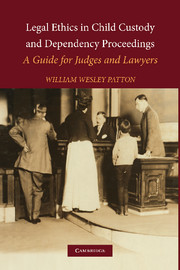Book contents
- Frontmatter
- Contents
- Foreword, by Martin Guggenheim
- Acknowledgments
- Introduction
- 1 Conflicts of Interest
- 2 Competent and Zealous Representation
- 3 Confidentiality
- 4 The Ethics of Alternative Dispute Resolution in Child Custody and Dependency Proceedings
- 5 Ethical Considerations and Constraints in Child Custody and Dependency Appeals
- 6 The Constitutionality of Legislative and Executive Regulation of the Practice of Law and Defining the Attorney-Client Relationship
- Appendix A National Association of Counsel for Children Standards
- Appendix B American Bar Association Standards of Practice for Lawyers Who Represent Children in Abuse and Neglect Cases
- Appendix C In re Car Simulation and Analysis
- Other Authorities
- Cases and Ethics Opinions
- Index
4 - The Ethics of Alternative Dispute Resolution in Child Custody and Dependency Proceedings
Published online by Cambridge University Press: 24 July 2009
- Frontmatter
- Contents
- Foreword, by Martin Guggenheim
- Acknowledgments
- Introduction
- 1 Conflicts of Interest
- 2 Competent and Zealous Representation
- 3 Confidentiality
- 4 The Ethics of Alternative Dispute Resolution in Child Custody and Dependency Proceedings
- 5 Ethical Considerations and Constraints in Child Custody and Dependency Appeals
- 6 The Constitutionality of Legislative and Executive Regulation of the Practice of Law and Defining the Attorney-Client Relationship
- Appendix A National Association of Counsel for Children Standards
- Appendix B American Bar Association Standards of Practice for Lawyers Who Represent Children in Abuse and Neglect Cases
- Appendix C In re Car Simulation and Analysis
- Other Authorities
- Cases and Ethics Opinions
- Index
Summary
INTRODUCTION
America's child custody and dependency systems would collapse if most cases were not disposed of through some form of alternative dispute resolution. However, overloaded systems are not merely a recent phenomenon. During the early child reform movements in the 1850s, child welfare systems were laden with children's cases. For instance, in 1879 the New York Children's Aid Society sent 48,000 poor New York children to live with another family, and “after its first fourteen years the New York Society for the Prevention of Cruelty to Children ‘investigated nearly 70,000 complaints of ill-treatment of 209,000 children. Prosecutions were pursued in 24,500 of these cases, resulting in almost 24,000 convictions and the removal of 36,300 children.’” So what has changed? What new pressures are forcing an ever-growing percentage of child abuse and child custody cases to settle prior to a formal adjudication?
First, the number of family law custody cases has exploded because of increased divorce rates in America:
In 1987, the first year divorce statistics were collected, the total number of divorces in the United States was just less than 10,000, about .03 per 1,000 people. By 1967, the divorce rate had jumped 140 times to 4.2 divorces per 1,000 people, or about 500,000. By 1981, the number of divorces had more than doubled to 1.21 million, about 5.3 divorces per 1,000. Because modern public policy recognizes divorce as a socially acceptable means of recording family relationships, demographers estimate that approximately forty-five percent of all current marriages will end in divorce.
- Type
- Chapter
- Information
- Legal Ethics in Child Custody and Dependency ProceedingsA Guide for Judges and Lawyers, pp. 88 - 119Publisher: Cambridge University PressPrint publication year: 2006

